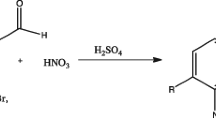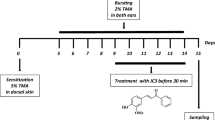Abstract
Inhibitors of arachidonic acid (AA) metabolism and other pharmacologic agents were evaluated against ear edema produced in mice by tetradecanoylphorbol acetate (TPA) or AA. Drugs were administered orally and topically either 30 min prior to AA or 30 min after TPA, except for steroids which were administered 2.5–3 hr prior to AA. Several cyclooxygenase (CO) inhibitors including indomethacin, aspirin, piroxicam and timegadine were without effect when administered orally against either irritant; the same drugs inhibited TPA edema when they were administered topically. Mixed CO/lipoxygenase (LO) inhibitors, phenidone and BW755C, were active orally against AA edema (ED50s of 84 and 65 mg/kg, respectively) and against TPA edema (ED50s of 235 and 88 mg/kg, respectively). Phenidone was more active topically against AA edema (ED50, 0.2 mg/ear) than (ED50, 2.8 mg/ear); however, BW755C was more active topically against TPA edema (ED50, 0.2 mg/ear) than phenidone (ED50, 0.6 mg/ear). Methylprednisolone was very effective in the AA (oral ED50, 17 mg/kg; topical ED50,>1 mg/ear) and TPA models (oral ED50, 4.3 mg/kg; topical ED50, 0.03 mg/ear. MK-447 was topically and orally effective only in the TPA model. Not surprisingly, drugs were more effective models were somewhat selective for CO and CO/LO inhibitors; however, dapsone was orally effective in the ear models, and a number of mediator antagonists and CNS drugs, especially anti-psychotics, were topically active primarily against TPA edema. These models may be useful for the detection ofin vivo activity of CO/LO or 5-LO inhibitors.
Similar content being viewed by others
References
T.J. Williams,Prostaglandin E 2,prostaglandin I 2 and the vascular changes of inflammation, Br. J. Pharmacol. 65, 517–524 (1979).
A.W. Ford-Hutchinson andA. Rackman,Leukotrienes as mediators of skin inflammation, Br. J. Dermatol. 109 (Suppl 25), 26–29 (1983).
E.J. Goetzl, M. Wong andM.S. Matthay,Leukotrienes in human hypersensitivity and inflammatory diseases, In, Advances in Inflammation Research, (Ed. I. Otterness, A. Lewis and R. Capetola) Raven Press, New York, in press.
T.J. Williams,Interactions between protaglandins, leukotrienes and other mediators of inflammation, Br. Med. Bull.30, 239–242 (1983).
A.W. Ford-Hutchinson,Leukotrienes: their formation and role as inflammatory mediators, Fed. Proc.44, 25–29 (1985).
M.A. Bray,The pharmacology and pathophysiology of leukotriene B 4, Br. Med. Bull.39, 249–254 (1983).
J.D. Levine, W. Lau, G. Kaviat andE.J. Goetzl,Leukotriene B 4 produces hyperalgesia that is dependent on polymorphonuclear leukocytes, Science225, 743–745 (1984).
J.M. Young, B.M. Wagner andD.A. Spires,Tachyphylaxis in 12-0-tetradecanoylphorbolacetate-and arachidonic acid-induced ear edema, J. Invest. Dermatol.80, 48–52, 1983.
J.L. Humes, E.E. Opas andR.J. Bonney,Arachidonic acid metabolites in mouse ear edema, In, Advances in Inflammation Research, (Ed. I. Otterness, A. Lewis and R. Capetola) Raven Press, New York, in press.
E.C. Arner, B.L. Rule, M.S. Rudnick andW. Galbraith,Arachidonic acid-induced ear edema: Correlation of swelling with production of lipoxygenase (LO) products, Agents and Actions, in press.
J. Chang, L. O'Neill-Davis, B. Lamb, R.P. Carlson, A.J. Lewis,The utility of arachidonic acid-treated mouse ear inflammatory model as a potential screen for lipoxygenase (LO) inhibitors, Agents and Actions, in press.
F. Marks, G. Furstenberger andE. Kownatzki,Prostaglandin E-mediated mitogenic stimulation of mouse epidermis in vivoby divalent cation ionophore A 23187 and by tumor promoter 12-0-tetradecanoylphorbol-13-acetate, Cancer Res.,41, 696–702 (1981).
J.M. Young, D.A. Spires, C.J. Bedford, B. Wagner, S.J. Ballaron andL.M. DeYoung,The mouse ear inflammatory response to topical arachidonic acid, J. Invest. Dermatol.82, 367–371 (1984).
R.P. Carlson, L. O'Neill-Davis, J. Chang andA.J. Lewis,Modulation of mouse ear edema by cyclooxygenase (CO) and lipoxygenase (LO) inhibitors, Agents and Actions, in press.
C.L. Ashendel andR.K. Boutwell,Prostaglandin E and F levels in mouse epidermis are increased by tumorpromoting phorbol esters, Biochem. Biophys. Res. Commun.90, 623–627 (1979).
J.L. Humes, S. Sadowski, M. Galavage, M. Goldenberg, E. Subers, R.J. Bonney andF.A. Kuehl, Jr.,Evidence for two sources of arachidonic acid for oxidative metabolism by mouse peritoneal macrophages, J. Biol. Chem.257, 1591–1594 (1982).
C. G. Van Arman,Antiinflammatory drugs, Clin. Pharmac. Ther.16, 900–904 (1979).
R.J. Flower,Macrocortin and the antiphospholipase proteins. In Advances in Inflammation, vol. 8 (Ed.G. Weissman) Raven Press, New York, 1984.
S.A. Saeed, W.J. McDonald-Gibson, J. Cuthbert, J.L. Copas, C. Schneider, P.J. Gardiner, N.M. Butt andH.O.J. Collier,Endogenous inhibitor of prostaglandin synthetase, Nature270, 32–36 (1977).
F.A. Kuehl, Jr., J.L. Humes, R.W. Egan, E.A. Ham, G.C. Beveridge andC.G. Van Arman,Role of prostaglandin endoperoxide PGG 2 in inflammatory processes, Nature265, 170–173 (1977).
J. Chang, M.D. Skowronek, M.L. Cherney andA.J. Lewis,Differential effects of putative lipoxygenase inhibitors on arachidonic metabolism in cell free and intact cell preparations, Inflammation8, 143–155 (1984).
R.P. Carlson, L.J. Datko, J. Chang, S.T. Nielsen andA.J. Lewis,The antiinflammatory profile of (5H-dibenzo[A,D]-cyclohepten-5-ylidene) acetic acid (Wy-41, 770), an agent possessing weak prostaglandin synthetase inhibitory activity that is devoid of gastric side effects, Agents and Actions14, 654–661 (1984).
Author information
Authors and Affiliations
Rights and permissions
About this article
Cite this article
Carlson, R.P., Lynn, OD., Chang, J. et al. Modulation of mouse ear edema by cyclooxygenase and lipoxygenase inhibitors and other pharmacologic agents. Agents and Actions 17, 197–204 (1985). https://doi.org/10.1007/BF01966592
Issue Date:
DOI: https://doi.org/10.1007/BF01966592




